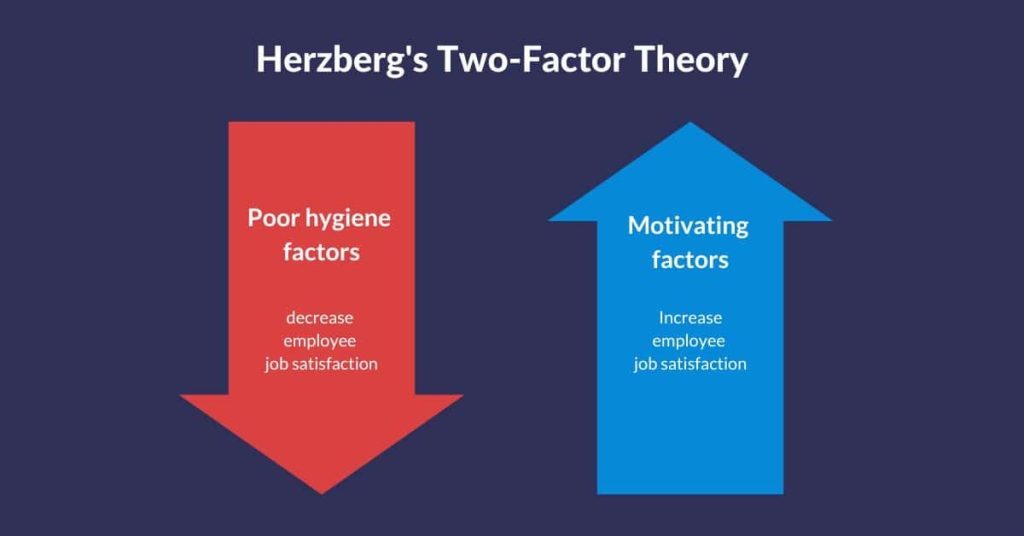
Introduction to Herzberg’s Two-Factor Theory
Herzberg’s 2-Factor Theory, developed by psychologist Frederick Herzberg in 1959, is a widely recognized framework for understanding employee motivation and job satisfaction. Herzberg conducted a study on employee satisfaction and dissatisfaction by interviewing workers about their experiences. Through his research, he identified two distinct factors that influence employee behavior: hygiene factors and motivators. According to Herzberg, hygiene factors prevent dissatisfaction, while motivators actively enhance job satisfaction and performance.
Hygiene factors, also known as extrinsic factors, include aspects of the job such as salary, work conditions, company policies, and job security. While these factors do not necessarily increase job satisfaction, their absence or inadequacy can lead to dissatisfaction. In contrast, motivators, also known as intrinsic factors, are linked to personal growth and fulfillment. These include achievement, recognition, responsibility, and opportunities for career advancement. Herzberg’s Two-Factor Theory suggests that to truly motivate employees, businesses must focus on enhancing these intrinsic factors rather than relying solely on improving hygiene factors.
The significance of Herzberg’s 2-Factor Theory lies in its ability to differentiate between what prevents dissatisfaction and what drives true motivation. It emphasizes that simply addressing hygiene factors—such as offering higher pay or better working conditions—may not lead to increased job satisfaction. Instead, businesses must also cultivate an environment where employees feel challenged, valued, and recognized for their contributions. By understanding and applying this theory, organizations can more effectively foster employee engagement, leading to improved productivity, retention, and overall job satisfaction.
Hygiene Factors in Herzberg’s Theory
In Herzberg’s Two-Factor Theory, hygiene factors are considered essential for preventing job dissatisfaction, but they do not necessarily lead to increased satisfaction or motivation. These factors include elements such as salary, work conditions, company policies, and job security. While hygiene factors address the fundamental needs of employees, their presence ensures a baseline level of contentment, but their improvement alone does not guarantee higher levels of motivation or job fulfillment.
For example, adequate pay is a critical hygiene factor. If employees feel they are compensated fairly, they are unlikely to be dissatisfied with their job. However, simply increasing salary without addressing deeper motivational factors may not lead to higher job satisfaction. Similarly, good working conditions and clear company policies are necessary to avoid dissatisfaction. If these factors are inadequate—such as having poor facilities or unclear policies—employees are more likely to become disengaged and frustrated.
Herzberg’s 2-Factor Theory emphasizes that while hygiene factors are vital for maintaining a stable work environment, they do not actively motivate employees. These factors are external to the individual and focus more on the job environment rather than the work itself. Companies that focus only on improving hygiene factors, such as offering better benefits or updating workspaces, may prevent employee dissatisfaction but are unlikely to see significant improvements in performance or engagement. To truly drive satisfaction, businesses must also address the intrinsic motivators that inspire employees to feel valued and engaged with their work.
Motivators in Herzberg’s Theory
In Herzberg’s Two-Factor Theory, motivators are the key elements that drive employee satisfaction and long-term motivation. Unlike hygiene factors, which prevent dissatisfaction, motivators are intrinsic and tied to the nature of the work itself. These include factors such as recognition, achievement, responsibility, and opportunities for personal growth. When these motivators are present, employees are more likely to experience higher job satisfaction and become deeply engaged in their work.
Recognition plays a critical role in employee motivation. When employees are acknowledged for their contributions, it fosters a sense of accomplishment and value. Simple acts of recognition, whether through praise from a manager or public acknowledgment within the team, can significantly boost morale. Additionally, achievement is a powerful motivator, as employees seek to complete meaningful tasks and overcome challenges. Success in these areas not only enhances job satisfaction but also reinforces an employee’s belief in their capabilities.
Personal growth and opportunities for development are also essential motivators in Herzberg’s 2-Factor Theory. Employees who feel they are advancing in their careers and acquiring new skills are more likely to remain committed and motivated. Providing opportunities for training, leadership roles, or increased responsibility can inspire employees to strive for excellence. Ultimately, motivators focus on fulfilling employees’ deeper psychological needs, such as the desire for self-improvement, purpose, and recognition. By nurturing these motivators, businesses can foster a more satisfied and productive workforce that is driven by a sense of purpose and accomplishment, leading to better overall performance and job retention.
Applications of Herzberg’s Theory in the Workplace
Herzberg’s Two-Factor Theory offers valuable insights for businesses aiming to improve employee engagement, retention, and overall job satisfaction. By understanding the distinction between hygiene factors and motivators, organizations can create more effective strategies to meet employee needs. One key application of this theory is recognizing that simply improving salary or working conditions, while important, may not lead to increased motivation or long-term job satisfaction. Businesses must go beyond addressing hygiene factors and focus on enhancing motivators to inspire employees.
To boost employee engagement, companies can implement programs that emphasize recognition and opportunities for growth. For example, introducing employee recognition systems, such as awards or public acknowledgment, can create a culture of appreciation. Providing opportunities for career development, such as leadership training or professional growth workshops, can also inspire employees to remain engaged and committed to their roles. According to Herzberg’s 2-Factor Theory, when employees feel recognized and see clear paths for advancement, they are more likely to feel satisfied and motivated.
Additionally, businesses can use Herzberg’s insights to improve retention. High turnover is often the result of dissatisfaction with hygiene factors, such as poor working conditions or inadequate benefits. However, focusing solely on these areas without addressing motivators may lead to short-term retention but fail to cultivate long-term loyalty. By creating a work environment that fosters achievement, responsibility, and personal growth, organizations can reduce turnover and increase job satisfaction. Employees who feel valued and have opportunities for advancement are less likely to seek employment elsewhere, which leads to higher retention and a more stable, motivated workforce. Applying Herzberg’s Two-Factor Theory in these ways enables businesses to create a thriving, motivated workplace that supports both employee and organizational success.
Criticisms and Modern Adaptations
Herzberg’s 2-Factor Theory has been widely influential, but it is not without its criticisms. One key critique is that the theory assumes hygiene factors and motivators are universally divided, which may not apply everywhere. Critics argue that factors like salary can function as both a motivator and hygiene factor, depending on context. Additionally, the theory relies on self-reported data from employees in Herzberg’s original study, raising questions about reliability. Employees may attribute positive outcomes to internal factors, like motivation, and negative outcomes to external ones, like working conditions. This can lead to biased results in the findings.
Another criticism is that Herzberg’s Two-Factor Theory oversimplifies the complexity of human motivation. Modern workplaces are highly dynamic, and employees’ motivations can change based on external pressures, industry trends, or personal circumstances. The theory also does not fully address the role of team dynamics or the impact of organizational culture on employee satisfaction. Despite these critiques, Herzberg’s work has been a foundation for further research and adaptation. For example, some companies have integrated Herzberg’s theory with other motivation models. For example, combined with Maslow’s Hierarchy of Needs, companies can create a more nuanced approaches to employee engagement. This integration allows for a more comprehensive understanding of how different factors interact to influence motivation.
Conclusion
In modern workplaces, Herzberg’s 2-Factor Theory has also been adapted to suit more flexible, team-oriented environments. Many companies have expanded the idea of motivators to include opportunities for teamwork, innovation, and creative freedom. Rather than focusing solely on individual achievement and recognition, businesses are recognizing the value of collaborative motivators. Additionally, with the rise of remote work, companies are increasingly emphasizing the importance of work-life balance as a motivator. By blending Herzberg’s ideas with contemporary workplace trends, companies can continue to benefit from his insights.
In conclusion, Herzberg’s Two-Factor Theory remains a valuable tool for understanding employee motivation and job satisfaction. By distinguishing between hygiene factors and motivators, the theory helps businesses recognize what prevents dissatisfaction and what truly drives engagement. While the theory has its limitations and critics, its core ideas continue to influence modern approaches to employee motivation. By adapting Herzberg’s insights to today’s dynamic work environments, companies can create strategies that foster long-term job satisfaction. This will enhance employee engagement, and improve overall retention. Ultimately, Herzberg’s 2-Factor Theory provides a foundation for building a more motivated and productive workforce.



